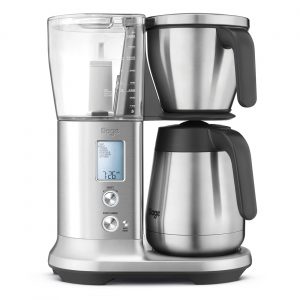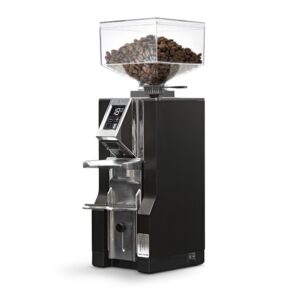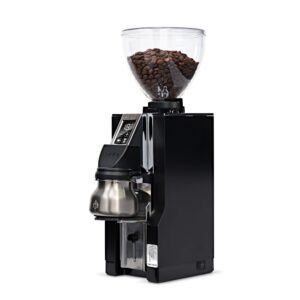I’ve heard about coffee getting stale over time. And here I am, returning after 10 days of vacation, and deciding to make a couple of flat whites from the beans I had left in the hopper.
First two shots ran at 3 bar. That’s for a coffee that usually runs at 7-9 bars. Only after purging the coffee, putting the beans from the bag and pulling another shot or two the pressure recovered.
Needless to say, I didn’t feel the need to taste the result of 3-bar coffee.
Tag: coffee
Aeropress Go Plus
Aeropress Go Plus is almost everything I wanted from Aeropress Go. It is slightly bigger. The plastic is clear and feels more robust. Actually, the entire thing is more robust. The cup is metal and thermal, and has a storage compartment at the bottom for extra paper filters. And it all fits very nicely.
The only downside for me is that you can’t fit the lid with the pressurized filter cap on. Aeropress Go had a rubber lid, so you could still stretch it, but Go Plus has a plastic lid. Still, I prefer this version much more, and I didn’t plan to use the lid anyway.
AeroPress Flow Control Filter Cap
After the trip to Texas, where AeroPress proved very useful, I decided that I want to try using a metal filter instead of disposable paper filters, despite the fact that those were widely available. Metal filter works, but the coffee drips even worse than with the paper filters. So the next step was to replace the default filter cap with a pressurized one.
Coffee machines use pressurized baskets to mitigate effect from coffee that was ground long time ago. Here, the idea is that a rubber gasket in the centre prevents coffee from dripping, until you start pressing it.
I’m yet to see the promised crema even with freshly ground coffee, byt at least I don’t end up with hands soaked in hot coffee, which is still a good thing.
Eureka Mignon Libra 65
The release of Eureka Mignon Libra 65 is a very interesting decision, and not because of the 65mm burrs.
The original Eureka Mignon Libra with 55mm burrs was one of two options for grind-by-weight at home (price range less than 1000GBP). It did a lot of things right: it’s very accurate, and compact.
But it’s ergonomics are terrible. Shitty bean hopper. Dial that doesn’t track the global position of the burrs. The nozzle is to far away, so the grounds fly all over. And there’s no tray to collect them.
As Eureka Mignon in general are quite popular grinders, though, enthusiast 3D-printed solutions for most of those problems. I bought a premium glass hopper from one of Eureka resellers, there’s a dial kit and a nozzle, and also a tray, which I have.
What Eureka did, it seems, is integrated most of those solutions into their new model. Now there’s a better hopper, better dial and a nozzle. They’re only missing the tray now.
Eureka Mignon Libra coffee grinder
Some more impressions.
The indirect grind control is indeed very nice. With Compak, you had to hold it with both hands to rotate. Here, you can do it with two fingers.
It is extremely precise once dialed. All my shots come out at exactly 35s.
That is, until you change the beans. And to be fair, I changed the beans 3 times, and everything was fine. But the beans from Back to Black just stopped the grinder dead, I had to remove them completely and start again.
Eureka Mignon Libra coffee grinder
I wanted a grind-by-weight coffee grinder since I bought my first coffee grinder, Compak K3 some 7 years ago. At the time, there was only Baratza Sette 270Wi. Strangely, seven years later, there aren’t many choices either: either same 270Wi or Eureka Mignon Libra. There are mixed opinions regarding Baratza’s connical burrs design and it’s ability to grind for espresso. So, I decided to give Eureka a chance.
First few impressions:
Tiny. With the hopper, it is as tall as K3 without one, and much shorter. The feel if very compact.
Sharp edges. Compak is all round. The machine is round cone, the hopper is a round “hat”. Eureka is all angles, so sharp I almost cut myself getting it out of the box.
Smooth and clean. Eureka is known for making very quiet coffee grinders. While not very important for me, it is noticeably quieter. What was far more important for me, and one of the reasons I finally decided to get a new grinder, is the clumps and distribution. In the meantime, the coffee is clumpless, and comes out as in the videos, in an even stream. That also means that despite me not getting my funnel yet, it doesn’t leave as much mess as Compak does.
Now, I still haven’t dialed the grind, simply because I didn’t want to waste coffee. So maybe it will get clumps once I grind finer. We’ll see soon enough.
A couple of weeks ago we replaced our rather simple Russel Hobbs filter machine with a more sophisticated Sage Precision Brewer.
 And boy, does it make a difference.
And boy, does it make a difference.
It doesn’t just pour boiling water, as some other brewers do. It controls water temperature using PID, like the higher-end espresso machines. The quality of coffee I get is comparable to filter coffee from Black Sheep. And it’s also easier to clean.
Potentially, it doesn’t even require paper filters. There’s a plastic basket that comes with it as well. But I got a stock of those paper filters during COVID, so I’m not sure if it’s worth to test the basket.
The downsides are that it’s huge. The tank is 1.7L, and it’s 1.7L of coffee. While we drink around 0.5L in the morning. So the pitcher always feels almost empty. I wish they had a smaller model for such cases.
Coffee habbits
For the past few months I stopped using any kind of thermometer when frothing the milk for my coffee, and started using “the hand method”. In my opinion, milk heathed to 60C is already hard to work with. So I keep it around 50C, or until the jug is hot to the hands touch.
I’ve been a fan of Ethiopian coffee for a long time now. But for the past few months, since April, we’ve been drinking a lot of Chinese coffee. It’s available only from one coffee roastery, Origin, as far as I know. But it’s absolutely fantastic.
Coffee that I won’t ever buy again, I think, is Union Coffee Roasters. Bought 1kg of Sumatra beans that turned out to be dark roast. Couldn’t finish them.

